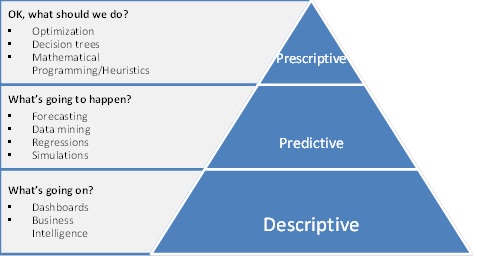As a modern-day marketer, you already know that your success lies in helping organizations become efficiently data-driven. That’s why the move from descriptive to predictive and then prescriptive analytics is an absolute must.
What’s The Difference?
The names themselves begin to give away the distinct differences between these two forms of analytics.
- Descriptive analytics use data aggregation and data mining. Descriptive analytics lets businesses see what has already happened.
- Predictive analytics use statistical models and forecasting. Predictive analytics helps businesses see what could happen in the future.
- Prescriptive analytics allows you to control what is being molded.
Descriptive analytics takes data an organization already has and presents it to them in an easy-to-digest way. This is helpful for looking at a past year’s sales and other historical data, but when it comes to making marketing decisions and other key business moves, you need more than historical data points.
This is where predictive analytics come in. Rather than just showing you how many sales a business made last year or even how many clicks a website got last month, predictive analytics looks to take large amounts of data and dig deeper into its meaning. Based on the data, it will make insight-based predictions that can help guide critical moves.
With the use of advanced statistical models and forecasting techniques, predictive analysis helps a business see the future possibilities so that they can better consider their next potential moves. In this way, predictive analytics have an invaluable role in informing business decisions.

Why Make The Switch?
The move to predictive analytics and then prescriptive analytics is a necessary one. By adopting data-driven intelligence, businesses will see multiple benefits.
First and foremost, predictive analytics will centralize an organization’s data and put it in one place for easy analysis and review. This in itself will improve a business’ decision making power because they’ll be basing decisions on all of their available data, not just a slice of it.
In addition, predictive analytics is focused on real-time views of the centralized data, which helps businesses anticipate issues. And, with personalization growing increasingly important, the proactive collection, analysis, and review of this data is extremely valuable.
All in all, the move to predictive analytics from descriptive analytics is a necessary one. Any organization unwilling to adopt this new form of data analysis is unlikely to keep up for long, especially with multiple industry leaders already being familiar with this powerful approach.
Drilling Down?
Prescriptive analytics is the area of business analytics (BA) dedicated to finding the best course of action for a given situation.
Prescriptive analytics can also suggest decision options for how to take advantage of a future opportunity. Or how to mitigate a future risk. It can also illustrate the implications of each decision option. In practice, prescriptive analytics can continually and automatically process new data. It improves the accuracy of predictions and provide better decision options.
Three Practical Uses:
1. Customer-focused sales and marketing
2. Product innovation and management
3. Streamlined operations and execution
Diagnostic Analytics
In contrast to descriptive analytics, diagnostic analytics is less focused on what has occurred but rather focused on why something happened. In general, these analytics are looking on the processes and causes, instead of the result. Here is an example diagnostic analytics “Revenue is up in the East coast and the likely reason is the increase in investment on targeted marketing approach, closure of a major competitor in the area.”
Take note that descriptive analytics cannot provide an answer to important questions such as “How can we avoid this from happening again?”